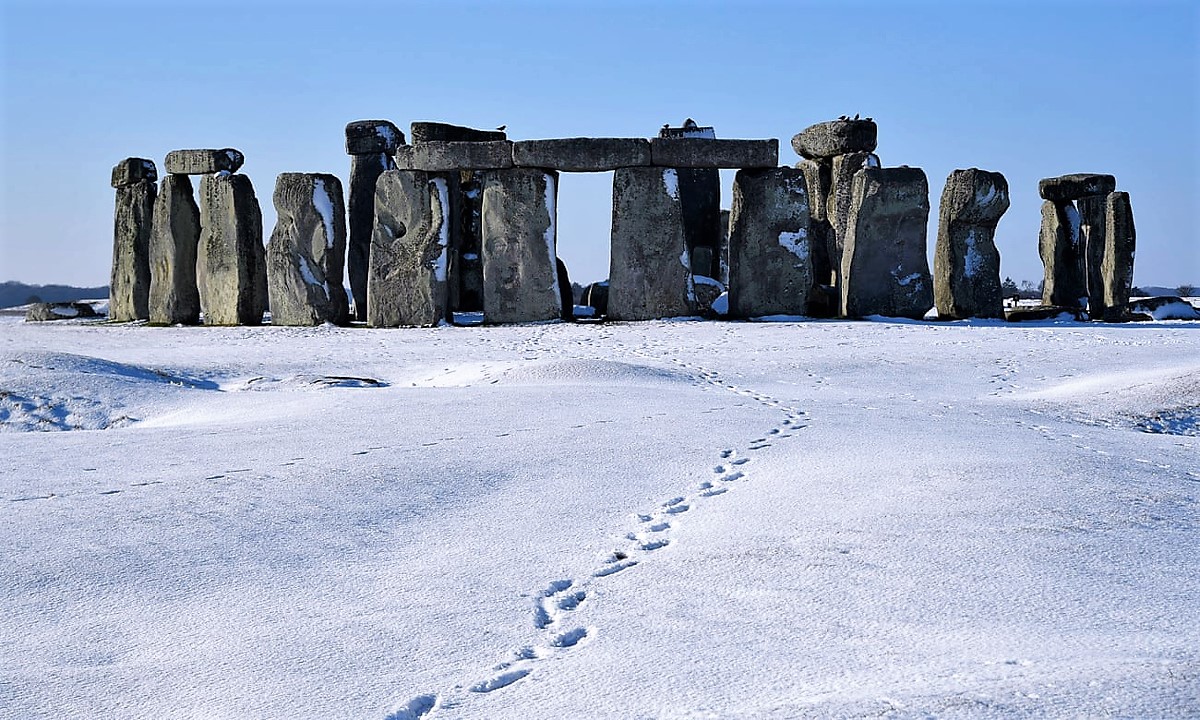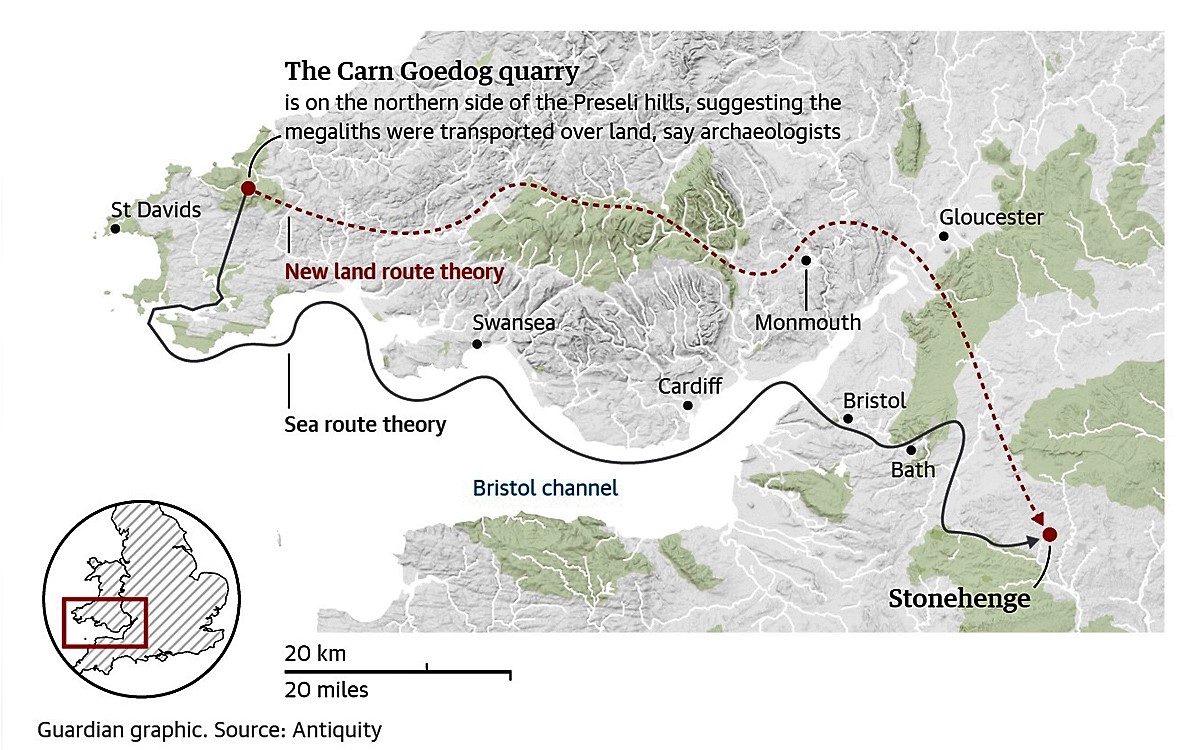


An article by Esther Addley on theguardian.com - Mega lift? Stonehenge pillars were carried 230km over land - reports on new discoveries which cast doubt on the theory that Stonehenge's bluestones were transported by sea. Archaeologists say up to 80 two-ton blocks may have been dragged from Preseli hills in Pembrokeshire.

Stonehenge: how did Neolithic builders, using only stone, wooden and bone tools, carve Stonehenge's bluestone pillars from the hilltops of western Wales? And how did they transport them more than 230km to Salisbury plain? Now, an excavation has found intriguing new evidence of the method by which the huge stones were chiselled out of the rock face at two craggy outcrops of the Preseli hills in Pembrokeshire. The location of the two monolith quarries, according to the archaeologists, undermines the theory that the stones were taken to Wiltshire by sea. Instead the two-ton blocks, up to 80 in number, were dragged or carried over land.

The archaeologists' research also supports the possibility that the bluestones - thought to date from the very first phase of construction at Stonehenge - may have first been used in a stone circle in Wales, before that monument was dismantled and transported hundreds of kilometres south-east, for reasons which remain a mystery.
Prof Mike Parker Pearson of University College London, who led the excavation, is hoping to answer why Stonehenge's stones came from so far away. He explains that every other Neolithic monument in Europe was built of megaliths brought from no more than 10 miles away.
Stonehenge's bluestones are not the enormous sarsen trilithons for which it is most famous, but a separate set of stones which now stand inside the sarsen ring but which, it is thought, may once have formed a much larger circle when the monument was first built, about 3,000BC.
Though smaller than the sarsens - and often overlooked by visitors as a result - they are still about two metres in height and would each have weighed about the same as a car, according to Dr Rob Ixer, one of the report's co-authors.
The new excavation focused on a crag called Carn Goedog, where the spotted dolerite rock naturally forms into pillar-shaped slabs. Parker Pearson and his team were able to identify recesses in the rock face from which pillars were quarried, carbon-dating charcoal found between the slabs to the fourth millennium BC.
They also discovered a number of distinctively wedge-shaped stone tools, formed from imported mudstone or sandstone, which they believe were hammered between the slabs in order to prise them apart, and identified V-shaped gaps between the pillars that they think were cut into the rock to let the wedge in. Their research is published in the journal Antiquity.
Excavation has also uncovered an artificial platform at the base of the outcrop, laid with stones. Prof Colin Richards suggests that the bluestone pillars could be eased down on to this platform, which acted as a loading bay for lowering them on to wooden sledges before dragging them away. A ditch dug next to the platform suggests the quarry may have been 'decommissioned' soon after the bluestones were removed, for reasons unknown.
The bluestones were previously thought to originate from the southern Preseli hills, but Ixer explains that the location of Carn Goedog and the other confirmed quarry on the northern slopes of the range completely changes the assumptions of how the stones were transported to Wiltshire. Instead of being dragged down the southern slopes to Milford Haven, and then transported by raft along the Severn estuary and along the River Avon to Salisbury plain, he believes that the stones were all manually transported - roughly following the route of the modern A40.
The bluestones were previously thought to originate from the southern Preseli hills, but Ixer explains that the location of Carn Goedog and the other confirmed quarry on the northern slopes of the range completely changes the assumptions of how the stones were transported to Wiltshire. Instead of being dragged down the southern slopes to Milford Haven, and then transported by raft along the Severn estuary and along the River Avon to Salisbury plain, he believes that the stones were all manually transported - roughly following the route of the modern A40.
Read more on Stonehenge:
The British Isles Prehistory Archive
by Bradshaw Foundation
Monday 04 December 2023
by Bradshaw Foundation
Friday 30 June 2023
by Bradshaw Foundation
Thursday 06 April 2023
by Bradshaw Foundation
Thursday 24 November 2022
by Bradshaw Foundation
Tuesday 27 September 2022
by Bradshaw Foundation
Thursday 08 September 2022
by Bradshaw Foundation
Tuesday 19 July 2022
by Bradshaw Foundation
Monday 06 June 2022
by Bradshaw Foundation
Friday 11 March 2022
by Bradshaw Foundation
Wednesday 02 March 2022
by Bradshaw Foundation
Thursday 26 August 2021
by Bradshaw Foundation
Monday 16 August 2021
by Bradshaw Foundation
Tuesday 06 July 2021
by Bradshaw Foundation
Thursday 06 May 2021
by Bradshaw Foundation
Thursday 06 May 2021
by Bradshaw Foundation
Tuesday 16 March 2021
by Bradshaw Foundation
Monday 04 December 2023
by Bradshaw Foundation
Friday 30 June 2023
by Bradshaw Foundation
Thursday 06 April 2023
by Bradshaw Foundation
Thursday 24 November 2022
by Bradshaw Foundation
Tuesday 27 September 2022
by Bradshaw Foundation
Thursday 08 September 2022
by Bradshaw Foundation
Tuesday 19 July 2022
by Bradshaw Foundation
Monday 06 June 2022
by Bradshaw Foundation
Friday 11 March 2022
by Bradshaw Foundation
Wednesday 02 March 2022
by Bradshaw Foundation
Thursday 26 August 2021
by Bradshaw Foundation
Monday 16 August 2021
by Bradshaw Foundation
Tuesday 06 July 2021
by Bradshaw Foundation
Thursday 06 May 2021
by Bradshaw Foundation
Thursday 06 May 2021
by Bradshaw Foundation
Tuesday 16 March 2021
Friend of the Foundation











